One look at the poll results should schedule product meetings across the truck camper industry. 439 poll participants and 82 comments make this a slam dunk decision.
If you’ve stayed at enough campgrounds, you are familiar with the sorry state of RV electrical hookups. All too often, campground electrical boxes are rusty, dirty, infested with insects and spider webs, and sometimes show signs of overheating – or worse.
After paying a considerable sum to camp, you are presented with a potentially camper-killing, vacation-destroying, trip-ending decision. Will you plug your truck camper into this electrical mess?
The best answer to this situation is either (a) always camping off-grid or (b) a proper portable or built-in surge protector. In reality, most of us plug into shore power at one time or another, even if it’s only at home or the houses of friends and family.
For this week’s Question of the Week, we polled our readers on whether or not the truck camper industry should include built-in surge protection into their truck campers.
The poll results are stunning:
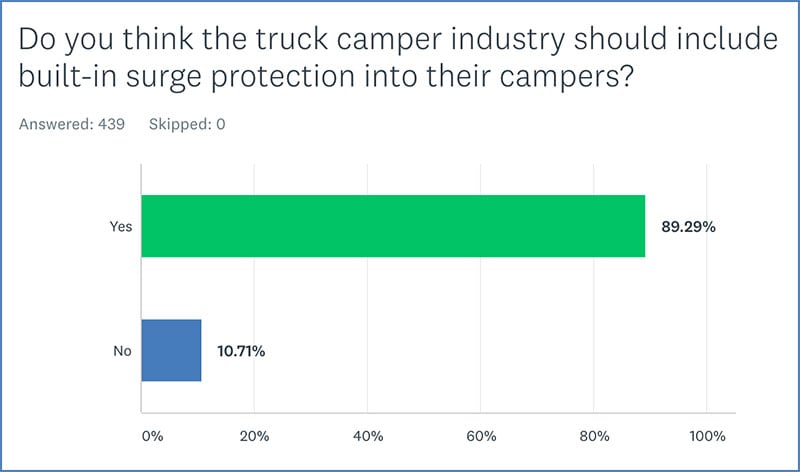
Here’s the best part; no truck camper manufacturer currently offers built-in surge protectors as standard, or as a factory option. 89-percent want this feature, and not one truck camper manufacturer offers it. I can’t think of another truck camper feature with this level of unsatisfied demand.
Before the industry rushes to fill this void, the readers have some important perspectives to share. First, not every truck camper owner wants or needs a built-in surge protector. Second, readers are concerned that the industry might install a sub-par quality unit, and charge too much for it.
That stated, I think the response to a manufacturer offering a Progressive Industries HW30C hardwired surge protector as an option would be incredibly well received. It may even sway a sale or two.
For the luxury brands, built-in surge protectors are a no-brainer – and a low-hanging competitive advantage waiting to happen.
This week’s Question of the Week was, “Why do you think built-in surge protection either should or should not be included in truck campers?”
“I believe the surge protection should be included. Cost should not be a concern. The manufacturers will purchase them in bulk. I can’t believe that the hardwired unit will really be much different in weight than the one that plugs in outside. I like the fact that the hardwired one won’t walk off while at a campsite.
I’m in the process of rebuilding my camper and will have a hardwired surge protector. I will have thirty-amp shore power, 12-volt off the truck, solar on the roof, and a generator that will all have a built-in surge protector – just like my house.” – Dean McCullor, 1990 Dodge W250, 1965 Avion C-10
“I am a big believer in the use of surge protectors. We have pulled into a number of campsites and found electric issues, loose and arcing sockets, 9.6-volts between the neutral and the ground, low voltage and (once) high voltage.
We were spared problems because we use a surge protector that displayed the problem and plugged right into the campground’s line. On two occasions the campground tried to argue that our equipment was at fault.
This winter, after seven years of use, our surge protector, obviously overheating, began to warp and was charing on the exterior, but was still passing current to the camper. If we had a built in surge protector I might never have noticed that, particularly if it was tucked into some out of the way location. We prefer the separate surge protector, not a built-in.” – James Kaley, 2018 GMC Sierra 3500, 2018 Northern Lite
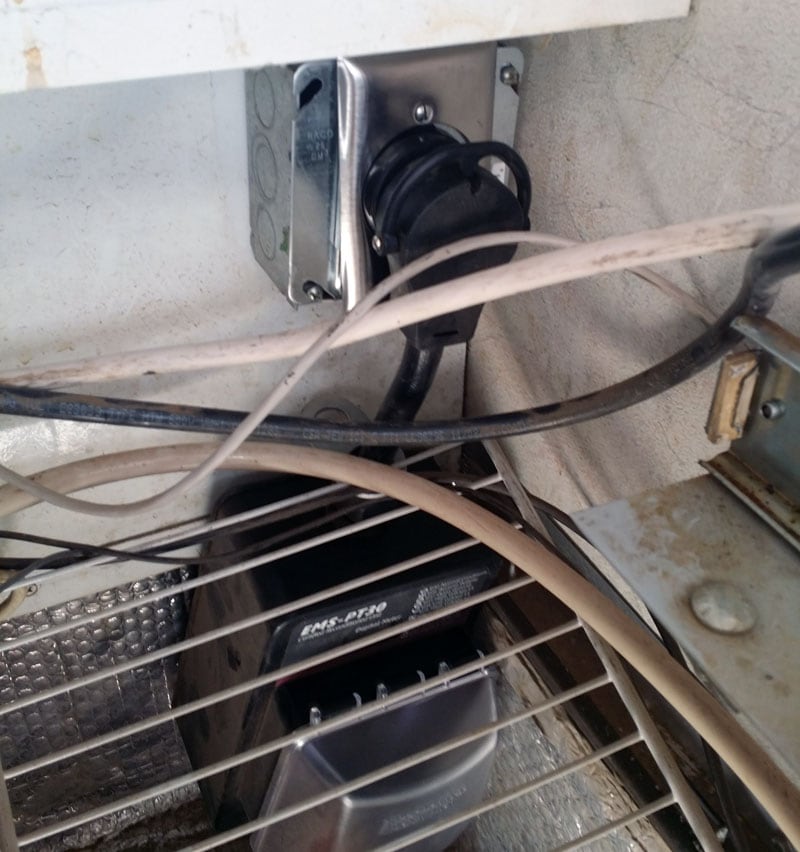
“Yes, I think built-in surge protectors should be an option. I bought an EMS PT30X for a previous travel trailer. I kept the surge protector when I sold the trailer. It was a minor, but noticeable hassle to use it when I was at a full hookup site. So I wired in appropriate plugs and outlets in the camper to make my PT30X a semi-permanent (removable) installation in my truck camper.” – Mark Joslin, 2006 Ram 3500, 2005 Lance 1181
“Cut out the frill and fluff and make it all optional; televisions, microwaves, radios, CD players (when is the last time you bought a CD), and outside speakers. Instead, install OEM items that extend the life of the camper’s living organs, such as batteries, electrical components, heaters, refrigerators, water systems, etc.
Items that prevent breakdowns need to be a higher priority than junky entertainment devices. We are truck camper travelers, not huge RV Class A motorhome and fifth-wheel buyers.
Hopefully the U.S. camper manufacturer’s will stop building the campers they traveled in during the 1960s and 70s and start bringing European and Australian-style rigs to the mass market camper buying public.” – Vince Wall, 2018 Ford F-350, 2016 Lance 850
“Built-in surge protectors should be an option. I checked yes in the poll, but having an option on what brand and features should be noted on the list. I don’t currently have one, but I should.” – Jeff Hagberg, 2002 Ford F250, 2006 Travel Lite 800 SBX
“We have an external surge protector that we purchased at Camping World that has demonstrated several times poor power in what are supposed to be top rated RV parks. We are carrying and storing the portable protector, so having a built-in one would just be more convenient.” – Sean Lynn, 2018 Ram 3500, 2014 Lance 950S
“I am not all that sold on surge protectors.” – Jim Mitchell, 2013 Ram 1500, 2015 Palomino SS-550
“It’s extra weight for a relatively rare problem.” – Randall Gilbertson, 2013 Ford F250, 2017 Wolf Creek 850
“Not all users of truck campers use equipment that sensitive to power current fluctuations. To make these folks pay for equipment that they don’t need or want is unAmerican!” – Rainer Mueller, 2015 Ford F-350, 2017 Host Mammoth
“l have learned from the past about fried RV electronics. I will never have a unit without a surge protector.” – Jan Satterlee, 2012 Ford F250, 2012 Lance 1050S
“As you stated, an outdoor surge protector has an invisible sign on it that says “take me!” – Mark Unger, 2017 Chevy Silverado 3500, 2017 Host Cascade
“It would be an added layer of protection. I have one for 30-amp that I use in campgrounds. I have a small one at home when I plug into 110.” – John Dorrer, 2013 Ford F-250, 2014 Four Wheel Camper Grandby
“We spend all this money for a camper just to bring it home and have to make these upgrades ourselves. It’s a safety issue – not an aesthetic upgrade.” – Michael Swiszcz, 2018 Ram 5500, 2019 Northern Lite 10.2
“With all the cell phones, laptops, and electronic devices that need charging, it would be very nice to have a decent and reliable surge protector built into the rig.” – Gary Swope, 2008 Toyota Tundra, No camper yet
“I think it should be one of those things that is just ready to go from the factory. You can pay for it now, or later. It gives you needed protection from the start.” – Don Silva, 2015 Ram 2500, 1997 Lance 165 Squire Lite
“Any RV plugged into shore power is likely using power sensitive equipment; televisions, computers, air conditioners, etc. It’s likely on an overloaded, outdated, poorly maintained RV park system.” – Dick Liebergen, 2017 Chevy 3500, 2007 Northern Lite 10-2 CDSE
“I have a Progressive Industries EMS-PT30X surge protector. I have to secure it with chain and lock after I plug in to an RV Park’s power pole. With a built-in camper surge protector you don’t have to worry about theft or it taking up space in a storage compartment. And you don’t have to have a chain and lock.” – Greg Gaser, 2014 Ford F350, 2017 Lance 1172
“They should include built-in surge protectors. I installed one in my 2001 Elkhorn Fleetwood, which was very easy to do. It was a Progressive Industries model. I will be installing one in the Bigfoot.” – John Mladjenovich, 2017 Chevy Silverado 3500, 2016 Bigfoot 10.6
“Surge protectors are just too expensive to hang on a post.” – Scottie Rome, 2015 Toyota Tundra, 2015 Northstar 650 Pop-up
“Yes, a 30-amp surge protector would not add that much weight to be concerned about. The cost would be cheaper then adding it yourself and will be done correctly from the manufacturer with the right size surge protector. With dealers charging $130 plus, let the builders install them!” – Bob Vea, 2003 Chevrolet 3500, 2003 Gulf Stream trailer
“Surge protectors should be included in the truck camper, or be a factory option. Truck camper electrical systems seem to be behind the times in general, as there are other items that should be included (or optional) like battery separators and whole-house battery disconnects.” – John Terescik, 2018 Ram 3500, 2016 Camplite 10.0
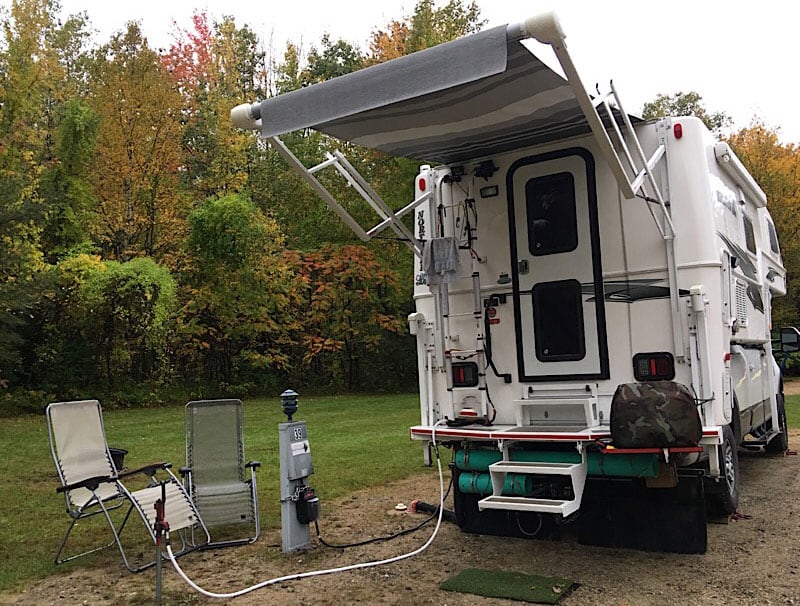
“Truck camper manufacturers should include a hardwired surge and electrical protector with a build quality at (or above) the EMS-PTS30X or the hardwired EMS-HW30C.
Surge protectors head-off shore power related issues that can trash the electrical system and/or devices in a camper. A hardwired unit offers greater convenience than one out on the pedestal. Not using one of these units when connected to shore power is a game of Russian electron roulette with each hookup.
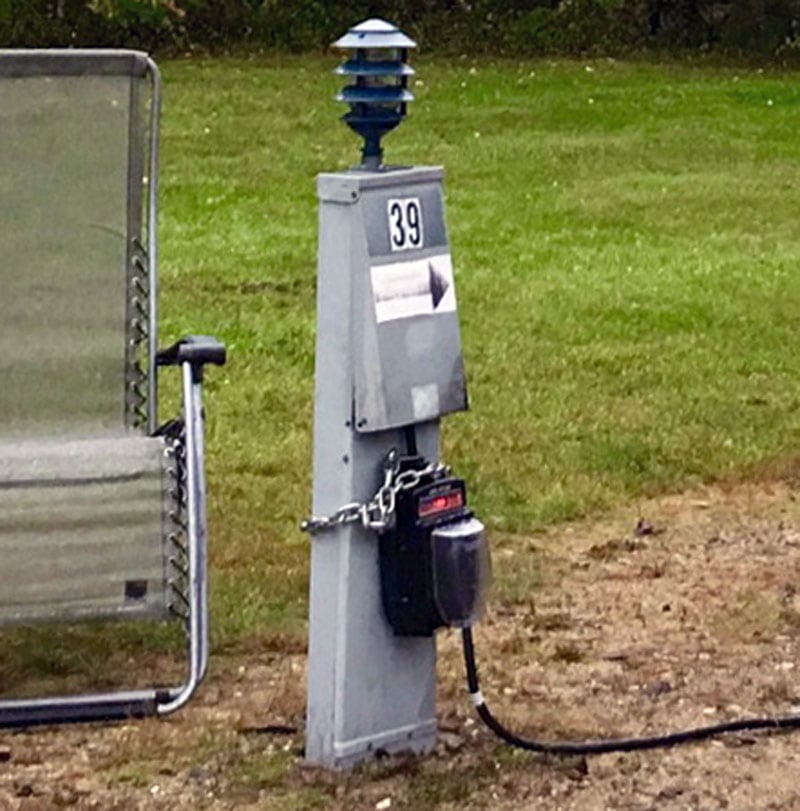
We are using an EMS-PTS30X. It has found pedestal related wiring faults numerous times, and it has detected many undesirable active power line events (disconnecting until the parameters become acceptable). We use a length of chain wrapped around the pedestal, secured with up to three padlocks in an attempt to keep it from walking off.” – Bill and Kira Jones, 2017 Ford F-350, 2018 Northern Lite 9-6Q SE
“My primary concern with the camper manufacturers including a built-in surge protector is that they would likely select the least expensive version they could find. And yet that item would likely increase the cost of the camper more than the best surge protector available on the market.” – Ken Pastorius, 2015 GMC 3500, 2012 Arctic Fox 1150
“Yes, of course, along with a device to shed electrical loads to match available power.” – Robert Mayton, 2014 Ford F450, No camper right now
“Theft prevention is certainly an extremely good reason. Let it be an optional item when selecting your make/model camper. I always wonder if I will forget to unplug the protector from the post when I’m at a campground. I also have to lock it to the post so that it doesn’t walk away.
I not only want built-in surge protection, but I also want lithium batteries as an option when making a purchase.” – Donald Fox, 2015 Ford F-450, 2018 Arctic Fox 990
“A surge protector saved my bacon when I tripped last year.
Yes, the good ones are expensive and need locks when not attended. When we read low voltage, we go to battery power which we know can last five days of frugal use (two Group 27 AGMs) without the solar. For us, our battery bank outlasts our fresh water water supply.
The first time I almost plugged into a 60-amp supply maybe nothing would have happened. I believe you have to have good data. You have to have a good surge protector.” – Jot McDonald, 2018 Silverado 3500, Adventurer 89RB
“First, it’s a simple addition. Maybe it could be an option to have one hardwired in the camper. Many truck campers boondock, but I’ve seen a lot who stay at private, state and national park campgrounds. Many campgrounds, if not most, are old and not maintained as they should. This has been my experience; old campgrounds with faulty hookups.” – Edith Horn, 2018 Ram 3500, 2019 Northern Lite 10-2EX CDLE
“Built-in surge protectors should be included. We had the internal Progressive Industries 50-amp HW50 in our fifth wheel. It identified incorrectly wired pedestals and low and high voltage situations, saving some expensive equipment in our fifth wheel.
We have a portable 30-amp Progressive Industries in our truck camper. It serves the same purpose as our 50-amp setup in our fifth wheel. Being portable, it is subject to weather and possibly theft. A hardwired system would be ideal. It is somewhat difficult after the camper is built, but much easier as it is being built.” – Rick Brundrige, 2015 Chevy Silverado 3500HD, 2000 Bigfoot C259.6
“We use a Progressive Industries surge protector at every place we plug into. Having it built-in would be nice. With our plug-in type I often think about what might happen during a heavy rain. Four years later, so far so good. We installed a security cable.” – Glenn Blount, 2012 F350, 2017 Lance 1172
“I believe we pay quite a bit for these campers and we should have them protected. Over the years we have had two surge protectors and both of them have come up among the missing when we get ready to get on the road again. If the protectors were hardwired into the camper to begin with there would be no problems with sticky fingers.” – Jerry Bonneau, 1995 Ford F350, 2002 Lance 1061
“Surge protection should be used, but not built into the camper. Camper manufacturers tend to bury items like this where you cannot easily get at them. So, when they go bad, as they always do, you’re stuck up that special creek without a paddle. Also, should you get a super surge that causes a fire at least the surge protector is outside the camper.” – Greg Meese, 2006 Ford F-350, 2018 Arctic Fox 1140
“I have the Progressive Industries HW30C 30-amp surge protector. I wired it into my camper myself and wouldn’t camp without it. Yes, I think that every RV, no matter what kind, should have one of these installed at the factory. It’s saved my bacon several times without the worry that someone will rip it off. It’s installed in my camper.” – Steve Cordis, 2000 Ford F250, 1996 Skyline Weekender
“To protect my investment, I consider it safety equipment that should be included or at least an option to include.” – Don Ball, 2016 Ram 2500, 2017 Cirrus
“The more that modern stuff and built-ins get added to truck campers, it takes away the raw and primitive aspect of this type of camper; all this stuff is turning truck campers into RV’s. I do not want radios, blue teeth, antennas, etc.
My type of camping consists mostly of boondocking – no shore power. Built-in surge protection is not required. For the few times I plug in, the external surge protector works just fine. It stays home when boondocking, thus not adding the little weight of it, meaning I could carry another 6-pack and not be over my GVWR.” – Frank Kaye, 2005 Ram 3500, Camper-less at the moment
“Yes, because I often forget to use the external surge protector.” – Joe Sesto, 2015 Silverado 3500, 2015 Bigfoot 2500 10.6E
“Built-in surge protectors should be optional. Or you should buy one from a store and hook it to the power supply coming in to protect everything.” – Mary Gibson, 2019 Ford F350, 1999 Lance
“I think the whole electrical system should be designed and incorporated into the camper. What I mean is that we have many electrical systems; solar with a charge controller, inverter, battery monitor, surge protector, generator and standard camper electric system. These systems should all be designed from the start to work together.” – Ron Richardson, 2014 Ram 3500, 2012 Wolf Creek 850
“Like your experience with the dogs, an out-of-limits power condition can exist in the most unexpected places. And don’t install the cheapest unit available – or at least give us a choice of units! Personally, I’d have the best well known unit installed that will cover all contingencies! You bet I’d pay the additional money for the peace of mind.” – Wes Brubacher, 2011 Chevy Silverado 3500, 2014 Lance 992
“Just like my house, safety.” – Marty Laplant, 2015 Silverado 3500HD, 2007 Lance 976
“It’s too apt to get stolen if it is not built into the camper.” – Stan Johnson, 2009 GMC 2500, 2009 Northstar Laredo
“I’m in the market for a truck and camper. I’ve previously owned three motorhomes and have never even heard about this problem or solution. I lost a refrigerator and now I know why. It was an $800 fix which was at a great discount because my cousin fixed the refrigerator. People need to be educated on this issue and then given the choice for a built-in surge protector.
As for manufacturers, I believe any manufacturer that is into quality and takes pride in their product will include this. I know I will be looking for this in any unit I purchase.” – Jesse Perez, No truck camper yet
“I’ve been in several campgrounds where the electrical connections are bad or wired incorrectly. My neighbor had is power quit. The camp ranger said he’d fix it. Well, he wired the 50-amp breaker incorrectly.
When my neighbor plugged back in the 220-voltage fried everything in his 5th wheel. We’re talking about the refrigerator, microwave, two televisions and few few other small appliances – all fried.
The park refused to pay for the damage but did give a discount on the fees. After that, we always put a surge protector (EMS) in my campers.” – HT Morgan, 2004 GMC 2500 HD, 2017 Cirrus 820
“They are easily added. I believe most users would be best served investigating their needs (is an educational process) and getting their own.
I don’t believe that having one installed by the manufacturer is a more economical method either. The manufacturer will add markup for the carrying cost of buying the device, engineering, labor and any associated marketing hype they can muster.
It’s fairly evident the cost of installing a hardwired aftermarket version is affected by the premium on labor encountered by any reputable RV service organization. The presence in the marketplace of pluggable devices seems to indicate the clear preference of the customer is for portable, not hardwired installation.” – Steve Hericks, 2004 Ford F350, 2000 Lance 1130
“If campgrounds are known as potentially more likely to have voltage surges, put one in. It’s a small price to pay.” – Frank Mehaffey, 2012 Ford F250, 2013 Camplite 10
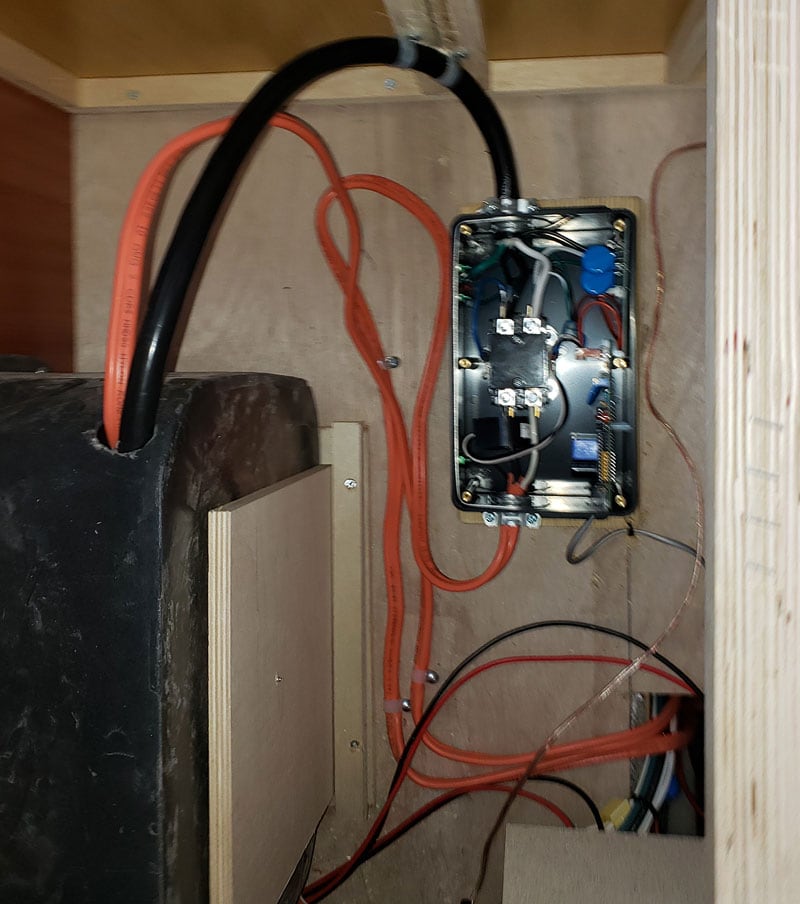
“An external surge protector is good insurance, but a built-in surge protector is even better because it makes it all most impossible for someone to walk away with it or to accidentally leave it behind.
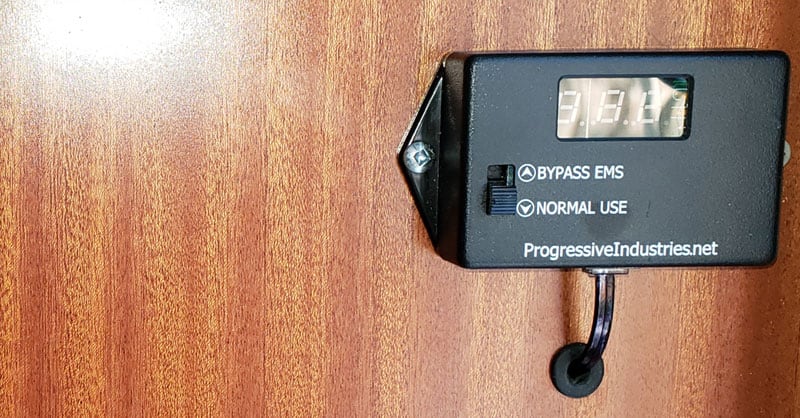
I have installed the Progressive Industries 30-amp model with remote display. It was incredibly easy to install the surge protector. However, the remote display was a challenge due to running the wires.” – Gary Sibert, 2018 Ford F350, 2019 Northern Lite 10-2
“Oh heck ya! While I rarely get to a campground with power, I use a surge protector to top off batteries and run the microwave. So yep, built-in surge protection should be an ‘option’ – and easy to get to.
Those plug into post expensive ones are just begging to be in the movie, ’Gone in Sixty Seconds’. Power to the People/Camper as they say…” – Frank Poole, Ram 5500, Arctic Fox 990
“I have the EMS system in my camper.” – Ronald Day, 2008 Chevy HD2500, 2005 Sunlite
“As mentioned in the article, built-in surge protectors would avoid expensive equipment being stolen and protect the appliances and electronics in the camper.” – John Virnig, 2002 Ford F350, 2010 Lance 950S
“When traveling I like to have built in protection. That way I am enjoying the adventure as opposed to working on repairs during fun time.” – Cavan Howard, 2018 Ford F450, 2018 Lance 1172
“We use surge protectors in the house on just about everything just to keep our electronics safe. Why would we not have that protection available installed from the factory to protect a very major investment?
If it’s a $1,000 dollar camper or a $50,000 dollar camper, one small power surge and you have a very expensive box with a bed. Factory or aftermarket surge protection is a must have.” – Brad Slatford, 2013 Ford F150, 1999 Adventurer 7.5
“Built-in surge protectors should be included. Yes, yes, yes! Weight is no problem.” – Real Charbonneau, 2008 Silverado, 2018 Travel Lite 800X
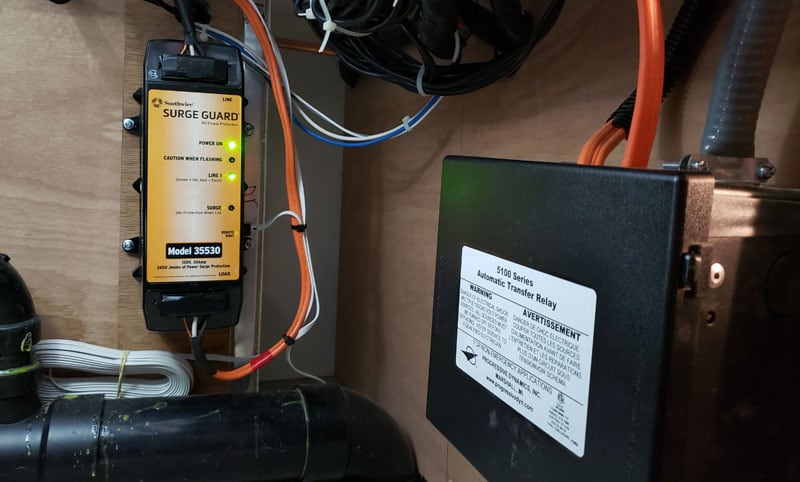
“I believe they should install not only a surge protector, but a unit like a Southwire surge guard that not only provides a surge protection, but voltage monitoring, reverse polarity, open neutral, and open ground.
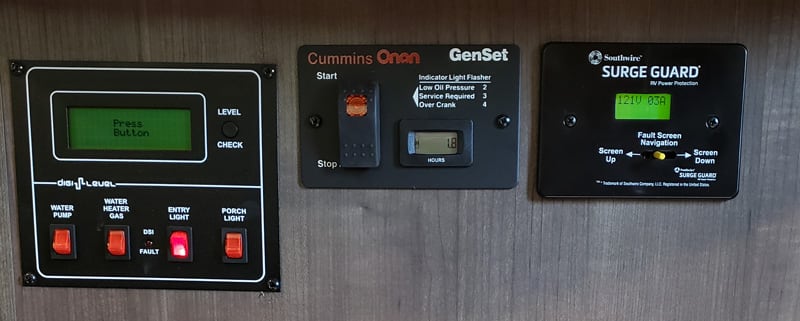
With the cost of just one appliance, the surge guard is a fraction of the cost to protect our appliances. I installed one on my unit.” – Frank Mertes, 2018 Ram 5500, 2018 Eagle Cap 1165
“I personally know of several RVs that were zapped during a storm. The cost of appliances and inconvenience is a big factor to have a surge protector. We boondock 90-percent of the time. When we do have hookups and there is a storm, we unplug. We are planning to purchase a surge protector in the near future.” – Angela Klinger, 2018 Ram 5500, 2017 Arctic Fox 1140
“If something is designed in from the start, it’s location and layout is usually better than trying to do it yourself.” – Pete Haidinyak, 2016 Ram 5500, 2016 Eagle Cap 1165
“It’s always needed, so why not included it.” – Michael Lucas, 2019 Ford F450, 2008 Okanagan 117
“No more worries if it’s installed.” – Barry Schoenwetter, 2006 GMC Sierra 2500HD, 2005 Lance 1030
“Your article is showing and addressing the need for a, “power management system” to guard against low voltage, high voltage, and surges – not just a surge protector. Based on my experience as an RV tech, high and low voltage is far more common than genuine surges.
While things have improved, low voltage in particular is still found in some campgrounds and can be both damaging and expensive to equipment. So yes, they should be standard equipment, although they are very easy to add as an aftermarket install. And, if you don’t want them as an install, just buy one of the models that plugs in ahead of your shoreline.
If you also have a built-in generator, make sure the install is ahead of your distribution panel – i.e breaker box.” – Steve Savage, 2012 Ford F350, 2019 Northstar Laredo
“I’m going to buy an external anyway. If it was built-in I wouldn’t, but I would like a way to bypass it if necessary.” – John Walicek, 2014 Ram 3500, 2019 Northern Lite 9.6
“The expense and weight aren’t a barrier since we have to buy and carry the external surge protector in the truck. A built-in would mean one less piece of gear to hassle with. Great idea!” – Anne Stauffer, 2017 Alaskan 8.5
“Surge protectors should be included. I’d use one regardless so cost. Weight issues are moot. Having it built-in would be much more convenient, and no theft worries.” – Brett Burguard, 2017 Ford F-350, 2012 Northstar 9.5 Igloo U
“I put that model in my fiver. Really not that heavy and what’s the difference installed or portable? Did it save my bacon? I don’t know but it was working when I sold the fiver. Just piece of mind.
It would be cheaper (I think) if built-in surge protectors were installed at factory. That takes away the fear factor that someone my steal a portable. If factory installed, I’d be set.” – Thomas Becher, 2011 Chevy 2500HD, 2018 Travel Lite 840SBRX
“A built-in surge protector should be included for security purposes and, if permanently installed, I would never forget to use it” – Floyd Tucker, 2003 GMC 2500HD Diesel, 2005 Lance 821
“The damage a high voltage surge may do can potentially destroy a camper. The hassle of deploying a conventional external surge protector can, at times, discourage its use. Further, the theft issue can be a nuisance not to mention expensive. Finally, storing an external unit just hits the storage hot button one more time. Everyone should consider a surge protector cheap insurance and they should be in use.” – Louis Pomerville, 2008 Silverado 3500HD, 2008 Snowriver 102RK
“Built-in surge protection should be standard equipment wired right after the electrical input plug. Camping with hookups does not always have the best electrical service available for your sensitive equipment. The added protection of a built-in device for filtered electrical power should be a necessity. Water filters are becoming standard. Why not an, “electrical filter” as well? Happy trails.” – MJ Mohn, 2012 Ford F350, 2004 Snowriver 102RK
“Surge protectors are a sacrificial component, meaning when they do their job and prevent a true surge, they will most likely need to be replaced. There is no guarantee that the truck camper manufacturer will place them in an easy to reach area and make them easy to replace.
The manufacturer’s choice might be overkill, thereby increasing the price excessively or they may cheap out and under protect trying to hold their expenses down. I’d rather choose my own.
We have had a very expensive outside, 50-amp surge protector on our full-time motorhome. Although I was worried someone would steal it, no one has in 21 years, but I did have to replace a previous cheaper version.
I have a less expensive 20-amp surge protector on my Four Wheel Camper Eagle and no one has stolen that either.” – Larry Chiuppi, 2009 Ford Ranger, Four Wheel Camper Eagle shell
“Given the cost of upscale campers these days, is it too much to ask to have the manufacturers build in absolutely necessary power system protection?” – Holger Fuerst, 2012 Ford F450, 2014 Lance 1172
“I think it should be an optional item. We were just warned, by the camp hosts where we are now, that external surge protectors were recently stolen here by drive-bys. I am aware that locks can be purchased for external surge protectors, but I am not aware how easily, or if they can be cut off.
That said, even the built-in ones are not totally free of potential damage. We had friends, at a Corps of Engineer’s park in Pennsylvania, that had their 50-amp built-in protectors blown out when one leg of the 50-amp power supply failed (either shorted out or opened). The repair was very expensive and difficult to find the correct parts and a qualified repair center.” – Carl Goode, 2016 Ram 3500HD, 2008 Okanagan 116DBL
“With so much consumer electronics being taking along these days, as well as sensitive inverter/converters and fancy solar controllers, I believe built-in surge protectors are the way to go.
We know from experience. In Alaska, when we were on commercial generator shore power, we lost an onboard converter due to a power surge. We had solar power only from Alaska back to Idaho. If it had happened to our friends traveling with u,s they would have had to do expensive repairs on the extended trip.
We now use an onboard surge protector. So we think it would be great if new campers had the option of having installed surge protectors.” – Gary Gadwa, 2012 Ford F350, 2010 Eagle Cap 950
“I worked for a power utility before I retired. One thing discussed in a “smart grid” aspect was feeder voltage control to “trim” power consumption during peak hours.
Essentially, during peaks the load’s voltage (your house) is automatically lowered marginally at the substation, within “standard” specifications, to reduce the system total load. In theory, the load (watts) is the product of the voltage and the current (over simplification here). By lowering the voltage slightly, the current should drop (at least for lighting loads) and the total “system” load should drop. Bottom line, your “host” should have their power checked.” – Dave Williams, 2013 Chevy Silverado 3500HD, 2006 Lance 915
“Cost and weight. I haven’t needed one yet, but we only use the camper two weeks a year. It should be an option. If all you do is boondock you would never need one.” – Matt Reinker, 2016 Ford F150, 2007 Northstar TC650
“I’d rather purchase my own surge protector. With few exceptions, the RV industry trends toward installing the least expensive gadgets when they aren’t a major selling point. Tank level monitors are a prime example.” – Greg Chambers, 2015 GMC 3500, 2015 Lance 855s
“I went with my selected truck camper because it is really self-contained. I try to not stay in full hookup campgrounds. I don’t need the hookup. There are too many horror stories associated with them. It’s a different story with an RV trailer. Building in a surge protector would definitely be a plus.” – Dennis Wilcox, 2016 Ram 3500, 2019 Northern Lite 10.2 EX
“I think surge protection should be included. I have not had a surge problem in 12 years, but almost all our camping is boondocking. If you damage an appliance due to faulty power it would have been cheaper to have the protection in the first place.” – James Feeley, 2018 Chevy 2500HD, Northstar 2007 Igloo 9.5
“Electrical problems are common in campgrounds low or high voltages, mixed polarity, open grounds, power failures and surges. Hardwired surge protectors make more sense than portable outdoor units but both types can save a costly appliance repair.” – Grant Smith, 2015 Dodge Ram 3500, 2018 Four Wheel Hawk
“I do not have a truck camper (yet), but I think all campers should have a surge protector built-in. The small additional cost is worth the protection and peace of mind.” – Rick Rock, Chevy 1500, 2014 Coachmen travel trailer
“Your article said it all. The cost of portable serge protection is not cheap. Having it built-in would not only make this harder to steal, but would not add that much weight or cost. You also would not forget to use it. I have a portable now but I have been considering having one installed.” – Joe Munn, 2001 Ram 3500, 1998 Bigfoot 2500
“It should be part of the overall safety net to prevent unexpected surprises.” – R. Shaffer, 2016 Ram 3500, 2016 FWC Hawk
“I added the Progressive Industries HW30C immediately after I bought the camper new. It has protected the camper many times from poor or improperly wired hookups. The remote is nice for trouble codes and load draw information.” – Mark Voth, 2012 Chevy 3500 SRW, 2013 Northstar Arrow 8.5
“Everyone seems to think surge protectors are an important thing to have because of what seems to be a lot of problems with the campground’s service. It seems to me that built-in surge protectors would cheaper to install at the factory when the units are being built.” – Tim Chapell, 2013 Ford F-150, 2013 Palomino 1251SB
“Yes, for all of the reasons that you mentioned.” – Steve Rennells, 2017 GMC Sierra 3500 HD, 2004 Lance 1050
“I highly recommend Progressive Industries surge protectors. Anyone who can afford a camper should not flinch at the extra cost of proper power protection which would add a minuscule amount to the cost of a camper.
We just came back from a place where there clearly was not enough service to the campground and our unit kept cutting out at breakfast and supper time everyday. This indicated brownout conditions and the Progressive PT-30X saved our electrical inside. Nuff said.
When I went to politely explain to the manager of the campground, it was very clear to me that he did not understand what the issue was, let alone that I also told him to have a qualified electrician come in to verify what I was telling him. It was like talking to a deer. I think I’ll take the generator along for situations like that.
As for someone stealing the PT-30X, it’s not going to happen with my rig. Even though it is the portable unit, I mounted it inside the box on my Bigfoot camper by taking apart some things inside. The unit is out of sight and cannot be extracted from the box from the outside because the hole is too small.” – Lyle Tremblay, 2004 GMC 2500HD, 2006 Bigfoot 25C9.4
“We have also found some bad connections in many different states. Adding surge protection is another layer of safety for our camper’s electronics.” – Janet Manis, 2014 Ram 2500HD, 2015 Travel Lite 960R
